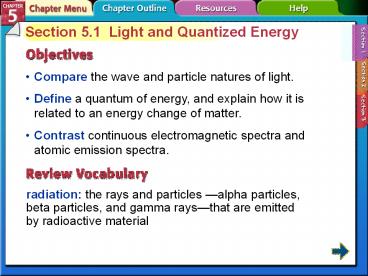Section 5.1 Light and Quantized Energy - PowerPoint PPT Presentation
1 / 20
Title:
Section 5.1 Light and Quantized Energy
Description:
Section 5.1 Light and Quantized Energy Compare the wave and particle natures of light. Define a quantum of energy, and explain how it is related to an energy change ... – PowerPoint PPT presentation
Number of Views:358
Avg rating:3.0/5.0
Title: Section 5.1 Light and Quantized Energy
1
Section 5-1
Section 5.1 Light and Quantized Energy
- Compare the wave and particle natures of light.
- Define a quantum of energy, and explain how it is
related to an energy change of matter. - Contrast continuous electromagnetic spectra and
atomic emission spectra.
radiation the rays and particles alpha
particles, beta particles, and gamma raysthat
are emitted by radioactive material
2
Section 5-1
Section 5.1 Light and Quantized Energy (cont.)
electromagnetic radiation wavelength frequency amp
litude electromagnetic spectrum
quantum Planck's constant photoelectric
effect photon atomic emission spectrum
Light, a form of electronic radiation, has
characteristics of both a wave and a particle.
3
Section 5-1
The Atom and Unanswered Questions
- Recall that in Rutherford's model, the atoms
mass is concentrated in the nucleus and electrons
move around it.
- The model doesnt explain how the electrons were
arranged around the nucleus. - The model doesnt explain why negatively charged
electrons arent pulled into the positively
charged nucleus.
4
Section 5-1
The Atom and Unanswered Questions (cont.)
- In the early 1900s, scientists observed certain
elements emitted visible light when heated in a
flame.
- Analysis of the emitted light revealed that an
elements chemical behavior is related to the
arrangement of the electrons in its atoms.
5
Section 5-1
The Wave Nature of Light
- Visible light is a type of electromagnetic
radiation, a form of energy that exhibits
wave-like behavior as it travels through space.
- All waves can be described by several
characteristics.
6
Section 5-1
The Wave Nature of Light (cont.)
- The wavelength (?) is the shortest distance
between equivalent points on a continuous wave.
- The frequency (f) is the number of waves that
pass a given point per second. The unit for
frequency is 1/sec or sec-1, which is known as a
Hertz. - The amplitude is the waves height from the
origin to a crest.
7
Section 5-1
The Wave Nature of Light (cont.)
8
Section 5-1
The Wave Nature of Light (cont.)
- The speed of light (3.00 ? 108 m/s) is the
product of its wavelength and frequency c ?f.
c ?f
9
EM Spectrum
- EX Find the frequency of a photon with a
wavelength of 434 nm.
GIVEN f ? ? 434 nm 4.34 ? 10-7 m c
3.00 ? 108m/s
f 6.91 ? 1014 Hz
10
Section 5-1
The Wave Nature of Light (cont.)
- Sunlight contains a continuous range of
wavelengths and frequencies.
- A prism separates sunlight into a continuous
spectrum of colors. - The electromagnetic spectrum includes all forms
of electromagnetic radiation.
11
Section 5-1
The Wave Nature of Light (cont.)
12
Section 5-1
The Particle Nature of Light
- The wave model of light cannot explain all of
lights characteristics.
- Matter can gain or lose energy only in small,
specific amounts called quanta. - Max Planck (1900) Observed - emission of light
from hot objects - Concluded - energy is emitted in small, specific
amounts (quanta) - A quantum is the minimum amount of energy that
can be gained or lost by an atom. - Plancks constant has a value of 6.626 ? 1034 J
? s.
13
Section 5-1
The Particle Nature of Light (cont.)
- The photoelectric effect is when electrons are
emitted from a metals surface when light of a
certain frequency shines on it.
14
Section 5-1
The Particle Nature of Light (cont.)
- Albert Einstein proposed in 1905 that light has a
dual nature.
- A beam of light has wavelike and particle like
properties. - A photon is a particle of electromagnetic
radiation with no mass that carries a quantum of
energy.
E hf
Ephoton hf Ephoton represents energy. h is
Planck's constant. f represents frequency.
15
Quantum Theory
- EX Find the energy of a red photon with a
frequency of 4.57 ? 1014 Hz.
GIVEN E ? f 4.57 ? 1014 Hz h 6.6262 ?
10-34 Js
WORK E hf E (6.6262 ? 10-34 Js)(4.57 ? 1014
Hz) E 3.03 ? 10-19 J
16
Section 5-1
Atomic Emission Spectra
- Light in a neon sign is produced when electricity
is passed through a tube filled with neon gas and
excites the neon atoms.
- The excited atoms emit light to release energy.
17
Section 5-1
Atomic Emission Spectra (cont.)
18
Section 5-1
Atomic Emission Spectra (cont.)
- The atomic emission spectrum of an element is the
set of frequencies of the electromagnetic waves
emitted by the atoms of the element.
- Each elements atomic emission spectrum is
unique. Like a finger print.
19
Section 5-1
Section 5.1 Assessment
What is the smallest amount of energy that can be
gained or lost by an atom? A. electromagnetic
photon B. beta particle C. quanta
D. wave-particle
- A
- B
- C
- D
20
Section 5-1
Section 5.1 Assessment
What is a particle of electromagnetic radiation
with no mass called? A. beta particle B. alpha
particle C. quanta D. photon
- A
- B
- C
- D































